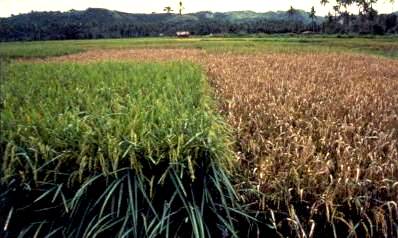|
|
|
Pest management |
|
||||||||||||||
|
|
|
|
|
||||||||||||||
|
|
|
IPM and diseases
|
|
||||||||||||||
|
|
|
|
|
||||||||||||||
|
|
|
Understand the value of IPM in dealing with diseases |
|
||||||||||||||
|
|
|
What do we mean by diseases?
Disease pathogens are mostly viruses, bacteria and fungi that are parasitic and live in or on rice plants. Their development depends on environmental factors, such as temperature, humidity, and light. There are more than 80 diseases of rice. The economically most important diseases are blast, sheath blight, and bacterial leaf blight. (See fact sheets on this disease below) |
|
||||||||||||||
|
|
|
How do diseases reduce yields?
|
|
||||||||||||||
|
|
|
How do I best control diseases?
There has to be a proper diagnosis of the disease before action against it is undertaken. Because the effectiveness of one method alone may be limited, it is best to control a disease by using a combination of things.
1. Choosing disease resistant varieties
Varieties resistant (left) and susceptible (right) to bacterial blast
In modern rice production, disease resistance in the host plant has played an important role in protecting the crop from diseases such as bacterial blight, blast, grassy stunt, and tungro.
Potential sources of resistance may be obtained from cultivars and wild relatives of rice. For example, about 15 genes each for bacterial blast and bacterial blight resistance have been identified from Oryza sativa, the cultivated Asian rice, and from wild relatives. Resistance has been transferred from Oryza minuta, a wild relative of rice, to cultivate rice through conventional and biotechnological methods used in plant breeding.
|
|
||||||||||||||
|
|
|
2. Balancing plant nutrition and good cultural management High yields often have been obtained through cultural management and intensive use of inputs (nutrients). Using high amounts of nutrients (especially N, P and K) often give high fungal disease intensity, which requires the application of fungicides. Sheath blight and stem rot in tropical Asia and of blast in subtropical Asia are examples of diseases caused by high input of nutrients.
In central and northern Vietnam, a farmer may spray fungicides to control sheath blight twice in a cropping season and three times to control blast. Farmers in China apply similar numbers of sprays.
Spraying fungicides is not always the solution!
|
|
||||||||||||||
|
|
|
3. Biological and chemical control. IPM in diseases Rice ecosystems are rich in natural biological control agents of rice disease pathogens. Current research assesses ways of either reintroducing or increasing these naturally occurring biological control agents to suppress diseases.
Knowledge of microbial ecology of pathogens is needed to develop long-term, sustainable strategies for disease management. Understanding mechanisms that suppress disease epidemics will be needed.
IPM and diseases
Applying the IPM concept to diseases requires a good, systems-oriented framework for integrating all available knowledge for each disease.
By understanding the diseases, we can identify the intervention points for effective control measures so that costs to farmers are reduced, but the control efficacy is improved.
|
|
||||||||||||||
More information |
|
Click on the icon to open a manual with more information on:
Click on an icon to open a fact sheet with specific information about the following diseases:
|
|
||||||||||||||
|
|
|
See also: |
|
||||||||||||||
|
|
|
|
|
||||||||||||||
Next lesson |
|
In the next lesson we will discuss the pest of weeds. |
|





